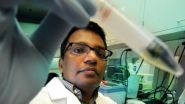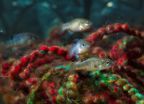(Press-News.org) What doesn't kill us may make us stronger as a group, according to findings from new research published in Psychological Science, a journal of the Association for Psychological Science.
The research suggests that, despite its unpleasantness, pain may actually have positive social consequences, acting as a sort of "social glue" that fosters cohesion and solidarity within groups:
"Our findings show that pain is a particularly powerful ingredient in producing bonding and cooperation between those who share painful experiences," says psychological scientist and lead researcher Brock Bastian of the University of New South Wales in Australia. "The findings shed light on why camaraderie may develop between soldiers or others who share difficult and painful experiences."
Bastian and colleagues Jolanda Jetten and Laura J. Ferris of the University of Queensland examined the link between pain and social bonding in a series of experiments with undergraduate students.
In the first experiment, the researchers randomly assigned 54 students to perform either a painful task or a similar, relatively painless, task in small groups. The students submerged their hand in a bucket of water and were tasked with locating metal balls in the water and placing them into a small underwater container. For some, the water was painfully cold, while for others the water was room temperature.
A second task required the students to either perform an upright wall squat (which is typically painful) or to balance on one leg, with the option of switching legs and using balance aids to avoid fatigue.
The students then rated statements designed to measure how they felt about their group (e.g., "I feel part of this group of participants," "I feel a sense of loyalty to the other participants").
The students who performed the painful tasks and those who performed the painless tasks showed no difference in positive or negative emotion.
They did, however, show significant differences in group bonding: Students who performed the painful tasks reported a greater degree of bonding than did those who performed the pain-free versions, even after the researchers accounted for participant age, gender, and the size of the group.
And the researchers found that shared pain not only increases a sense of solidarity, it can also boost actual group cooperation.
In an experiment with another set of students, each group played a game that involved choosing numbers between 1 and 7 — if everyone in the group chose 7, they would get the highest payoff. But, if they chose different numbers, those who picked lower numbers would get a greater payoff. The researchers found that students who had performed painful tasks as a group tended to pick higher numbers than those who performed the pain-free tasks, suggesting that they were more motivated to cooperate with the group.
"This finding puts the 'pain as social glue' hypothesis to a rigorous test, highlighting that people not only feel closer to others, but are willing to risk their own outcomes to benefit the group," says Bastian.
Shared pain even enhanced cooperation when the painful task involved eating a very spicy Bird's Eye chili pepper.
The researchers point out that the groups, created by random assignment, did not reflect any sort of shared identity other than their task-related experiences. The pain experienced by some of the students seemed to serve a unique causal function, focusing the students' attention on the shared pain and, ultimately, promoting group cohesion.
These findings offer insight into many social, religious, and even sexual practices around the world that involve some element of pain. But the researchers argue that the findings may be relevant in a much broader sense to many of our everyday experiences:
"These kinds of painful experiences may be relatively common," notes Bastian. "Our findings therefore may have implications for understanding social processes apparent in settings such as boot camp-style physical training programs, team sports, executive challenges, and other physically challenging experiences shared with others. Sharing a spicy meal with friends may even have positive social consequences!"
INFORMATION:
This research was supported by Australia Research Council Discovery Grant DP140103716 (awarded to B. Bastian and J. Jetten).
For more information about this study, please contact: Brock Bastian at b.bastian@unsw.edu.au.
The article abstract is available online: http://pss.sagepub.com/content/early/2014/09/04/0956797614545886.abstract
The APS journal Psychological Science is the highest ranked empirical journal in psychology. For a copy of the article "Pain as Social Glue: Shared Pain Increases Cooperation" and access to other Psychological Science research findings, please contact Anna Mikulak at 202-293-9300 or amikulak@psychologicalscience.org.
Shared pain brings people together
2014-09-09
ELSE PRESS RELEASES FROM THIS DATE:
Exercise before school may reduce ADHD symptoms in kids
2014-09-09
EAST LANSING, Mich. – Paying attention all day in school as a kid isn't easy, especially for those who are at a higher risk of ADHD, or attention deficit hyperactivity disorder.
A new study from Michigan State University and University of Vermont researchers shows that offering daily, before-school, aerobic activities to younger, at-risk children could help in reducing the symptoms of ADHD in the classroom and at home. Signs can include inattentiveness, moodiness and difficulty getting along with others.
The study can be found in the Journal of Abnormal Child Psychology.
"Early ...
Scientists discover hazardous waste-eating bacteria
2014-09-09
Tiny single-cell organisms discovered living underground could help with the problem of nuclear waste disposal, say researchers involved in a study at The University of Manchester.
Although bacteria with waste-eating properties have been discovered in relatively pristine soils before, this is the first time that microbes that can survive in the very harsh conditions expected in radioactive waste disposal sites have been found. The findings are published in the ISME (Multidisciplinary Journal of Microbial Ecology) Journal.
The disposal of our nuclear waste is very challenging, ...
Estrogen receptor expression may help explain why more males have autism
2014-09-09
AUGUSTA, Ga. – The same sex hormone that helps protect females from stroke may also reduce their risk of autism, scientists say.
In the first look at a potential role of the female sex hormone in autism, researchers at the Medical College of Georgia at Georgia Regents University have found expression of estrogen receptor beta – which enables estrogen's potent brain protection – is significantly decreased in autistic brains. The receptor also plays a role in locomotion as well as behavior, including anxiety, depression, memory, and learning.
"If you ask any psychiatrist ...
Phosphorus a promising semiconductor
2014-09-09
Defects damage the ideal properties of many two-dimensional materials, like carbon-based graphene. Phosphorus just shrugs.
That makes it a promising candidate for nano-electronic applications that require stable properties, according to new research by Rice University theoretical physicist Boris Yakobson and his colleagues.
In a paper in the American Chemical Society journal Nano Letters, the Rice team analyzed the properties of elemental bonds between semiconducting phosphorus atoms in 2-D sheets. Two-dimensional phosphorus is not theoretical; it was recently created ...
A system that facilitates malware identification in smartphones
2014-09-09
Malware is a type of malicious program whose general aim is to profit economically by carrying out actions without the user's consent, such as stealing personal information or committing economic fraud. We can find it "in any type of device ranging from traditional cell phones to today's smartphones, and even in our washing machine," explained one of the researchers, Guillermo Suarez de Tangil, from the Computer Science Department at UC3M.
With the massive sales of smartphones in recent years (more than personal computers in all of their history), malware developers ...
Testing the fossil record
2014-09-09
Palaeontologists have developed methods to try to identify and correct for bias and incompleteness in the fossil record. A new study, published on 4 September 2014 in the journal Nature Communications, suggests that some of these correction methods may actually be misleading. The work is led by Dr Alex Dunhill (University of Leeds, formerly at the Universities of Bath and Bristol), together with Hannisdal (University of Bergen) and Professor Michael Benton (University of Bristol).
Back to the origin of animals
"The Earth keeps changing. Life keeps evolving. And there ...
How age alters our immune response to bereavement
2014-09-09
Young people have a more robust immune response to the loss of a loved one, according to new research from the University of Birmingham, providing insight into how different generations cope with loss.
The study, published in the journal Immunity and Ageing, shows how the balance of our stress hormones during grief changes as we age – meaning elderly people are more likely to have reduced immune function and, as a result, suffer from infections.
It is the first research to compare different generations and display the relationship between stress hormones and immune ...
Myriad myPath™ melanoma test reduced indeterminate cases by 76 percent
2014-09-09
SALT LAKE CITY, Utah, Sept. 9, 2014 – Myriad Genetics, Inc. (Nasdaq: MYGN) today presented results from a pivotal clinical utility study of the Myriad myPath™ Melanoma test at the 2014 College of American Pathologists (CAP) annual meeting in Chicago, Ill. Myriad myPath Melanoma is a novel diagnostic test that differentiates malignant melanoma from benign skin lesions with greater than 90 percent accuracy and helps physicians deliver a more objective and confident diagnosis for patients.
This study evaluated the impact of the myPath Melanoma diagnostic test on expert ...
Biologists try to dig endangered pupfish out of its hole
2014-09-09
Berkeley — Scientists estimate that fewer than 100 Devils Hole pupfish remain in their Mojave Desert home, but a conservation biologist at the University of California, Berkeley, is giving important guidance in the efforts to rescue them by establishing a captive breeding program.
Considered the world's rarest fish, with one of the smallest geographic ranges of any wild vertebrate, the tiny pupfish (Cyprinodon diabolis) – about one-inch long as an adult – neared extinction in spring 2013 when populations dropped to an all-time low of 35 observable pupfish. While more ...
Tracing water channels in cell surface receptors
2014-09-09
G protein-coupled receptors (GPCRs) are the largest class of cell surface receptors in our cells, involved in signal transmission across the cell membrane. One of the biggest questions is how a signal recognized at the extracellular side of a GPCR induces a sequence of conformational changes in the protein and finally evokes an intracellular response. EPFL scientists have now used computer modeling to reveal in molecular detail the structural transitions that happen inside GPCRs during the signal transduction process. They discovered that a central step in the trans-membrane ...




